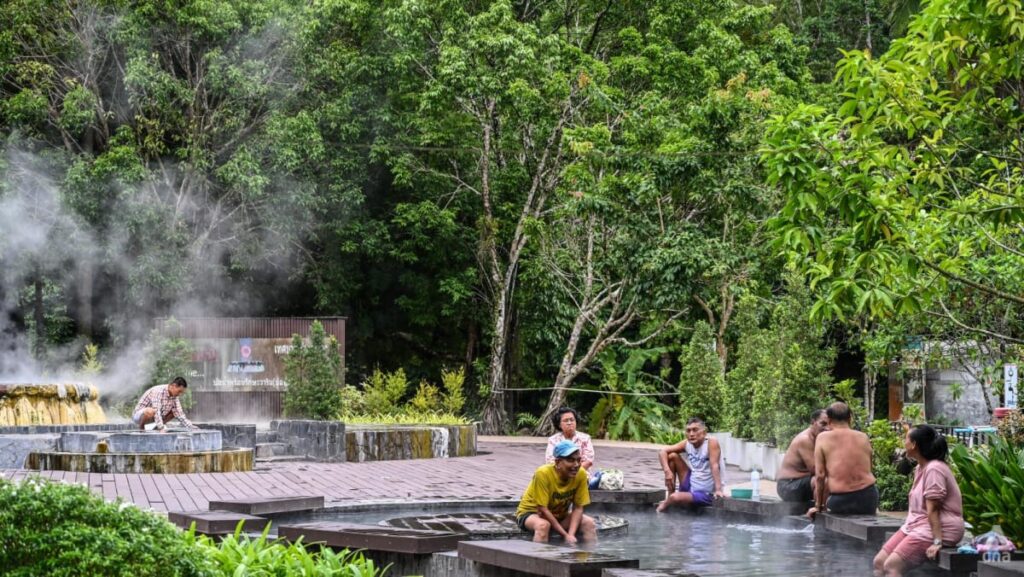In 2018, the hospital launched a hydrotherapy health centre, directly connected to hot spring waters.
It has multiple facilities for residents with mobility issues and offers treatment programmes under the supervision of orthopaedic specialists, physical therapists and sports medicine experts.
The centre resembles a small indoor pool. Mostly elderly visitors do passive exercise in the hot water or use specialised machines to assist their movement or rehabilitation from injury.
The hospital has larger ambitions and a budget ready to spend. By 2027, it plans to open a more modern wellness centre opposite the hospital, with the aim of attracting medical and leisure tourists from Thailand and the region.
“No other place is like Ranong. We have opportunities for this. It will help us to be able to promote the economy and promote health,” Siriwat said.
TOURISM KICKSTARTERS?
Despite the long, steeped history of Ranong’s natural spring resources, the wellness industry here has struggled to make international inroads.
The province has struggled to rebound its overall tourism numbers since the COVID-19 pandemic. In 2023, it attracted only 51,432 international tourists, a notable decline from the 282,322 in 2019.
Ranong had the eighth-lowest gross provincial product (GPP) output in the entire country in 2021. It was also in the top 10 for provinces with the highest poverty levels in 2022, according to the Office of the National Economic and Social Development Council.
The province has suffered from a lack of investment in recent decades. Old industries like forestry and mining have been phased out and tourism has been vastly outstripped by nearby southern hotspots.
Phuket drew about 8.4 million foreign tourists in 2023, while Krabi welcomed over 3.4 million international visitors.
Ranong tourism and business officials see wellness trails, with a focus on its hot spring resources, as a way to connect it to its more popular provincial neighbours.
The TAT strategy includes plans to develop seven hot spring routes across the country. An “Andaman Wellness Corridor” could viably link springs in Krabi, Ranong, Phang‑Nga, Trang and Satun – all provinces in the south.
Somchok said tourism officials would also like to better market Ranong as a place to relax and recuperate after more strenuous adventure activities nearby.
The province is also supposed to be the starting point of the proposed Thailand Land Bridge project, a contentious project that could see shipping trade bypass Singapore and Malaysia by connecting the Andaman Sea with the Gulf of Thailand.
Local industry groups, while generally wary about the potential environmental impacts of the proposed megaproject, say it could give an economic and connectivity boost to the wellness tourism strategy.
Two deep sea ports would be built in Ranong and Chumphon provinces and be linked by 90km of highways, railways and pipelines across the Kra Isthmus – the narrowest section of the Malay peninsula.
The first phase of the land bridge project was initially projected to finish by 2030, with the final completion targeted in 2039.
However, the project is far from certain to be built and has faced political hurdles, local resistance and uncertainties around the sources of investment for the US$36 billion plan.
“When big investors come, it will attract international tourists … to visit Ranong. There will be more airlines because businesspeople will fly here. Their travels here will make tourism more flexible. It will come in all the same pipe,” said Sonchai Uitekkeng, the vice president of the Ranong Provincial Chamber of Commerce.
Somchok said more infrastructure would help tourism but worried about developing too quickly.
“If a lot more people come, we can’t cater (to them),” he said.
It comes as Thailand looks to recalibrate its tourism goals as it struggles to regain international visitor numbers, which peaked in 2019.
With its international tourism industry dipping, Thailand is now doubling down on a “quality over quantity” gameplan, with a focus on higher-spending visitors.
https://www.channelnewsasia.com/asia/thailand-hot-springs-rivals-japan-onsen-wellness-tourism-push-5230426


